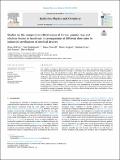| dc.contributor.author | McEvoy, Brian | |
| dc.contributor.author | Maksimovic, Ana | |
| dc.contributor.author | Howell, Daniel | |
| dc.contributor.author | Reppert, Pierre | |
| dc.contributor.author | Ryan, Damien | |
| dc.contributor.author | Rowan, Neil J. | |
| dc.contributor.author | Hervé, Michel | |
| dc.date.accessioned | 2023-03-31T15:19:08Z | |
| dc.date.available | 2023-03-31T15:19:08Z | |
| dc.date.copyright | 2023 | |
| dc.date.issued | 2023-03-17 | |
| dc.identifier.citation | McEvoy, B., Maksimovic, A., Howell, D. Reppert, P., Ryan, D., Rowan, N., Michel, H. (2023). Radiation Physics and Chemistry. 28: 110915. | en_US |
| dc.identifier.issn | 0969-806X | |
| dc.identifier.uri | https://research.thea.ie/handle/20.500.12065/4450 | |
| dc.description.abstract | The radiation resistance of Bacillus pumilus spores to gamma rays, X-rays, and electron beam (e-beam) was
investigated using industrial irradiators operating at various dose rates. The dose rates were as follows: gamma 1
and 10 kGy/h; X-ray 10 and 200 kGy/h; e-beam 2000 kGy/h. The regression analysis showed that survivor
curves were log10 linear for all three sources within the investigated absorbed dose range of 1–6 kGy, irrespective
of the dose rate applied. All irradiation technologies were equally efficient to inactivate the spores, which is
reflected in their comparable D-values (p > 0.05), and dose rate had no impact on the microbicidal efficacy.
These results suggest that wherever a specified minimum dose is delivered, the sterilization dose can be trans ferred between irradiation technologies in industrial sterilization of medical devices without any impact on
product sterility. These findings from a novel single study encompassing all available industrial radiation
technologies for the purpose of medical devices sterilization, advance our understanding of microbial destruction
as related to exposure to important sterilization modalities, which will help inform future applicability of these
technologies for emerging industry opportunities. | en_US |
| dc.format | PDF | en_US |
| dc.language.iso | eng | en_US |
| dc.publisher | Elsevier | en_US |
| dc.relation.ispartof | Radiation Physics and Chemistry | en_US |
| dc.rights | Attribution-3.0 United States | * |
| dc.rights.uri | http://creativecommons.org/licenses/by/3.0/us/ | * |
| dc.subject | Ionizing radiation | en_US |
| dc.subject | Industrial sterilization | en_US |
| dc.subject | Medical device | en_US |
| dc.subject | Dose rate | en_US |
| dc.subject | Microbial effectiveness | en_US |
| dc.subject | Technology transfer | en_US |
| dc.title | Studies on the comparative effectiveness of x-rays, gamma rays and electron beams to inactivate microorganisms at different dose rates in industrial sterilization of medical devices | en_US |
| dc.type | info:eu-repo/semantics/article | en_US |
| dc.contributor.affiliation | Technological University of the Shannon: Midlands Midwest | en_US |
| dc.description.peerreview | no | en_US |
| dc.identifier.doi | https://doi.org/10.1016/j.radphyschem.2023.110915 | en_US |
| dc.identifier.orcid | https://orcid.org/0000-0003-1228-3733 | en_US |
| dc.rights.accessrights | info:eu-repo/semantics/openAccess | en_US |
| dc.subject.department | Bioscience Research Institute TUS:MM | en_US |
| dc.type.version | info:eu-repo/semantics/publishedVersion | en_US |


